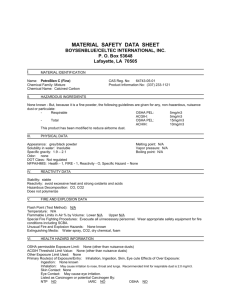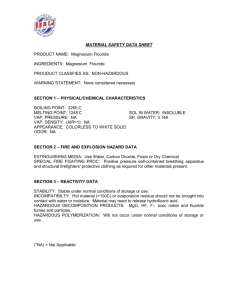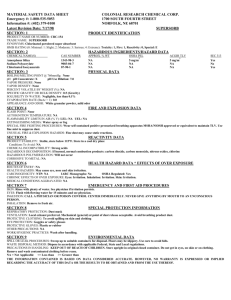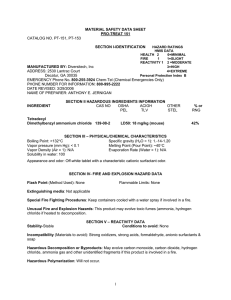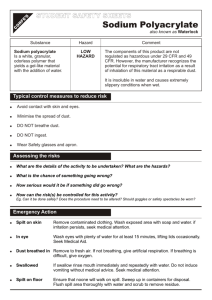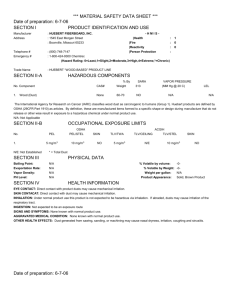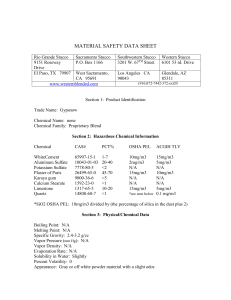Silicon Carbide MSDS
advertisement
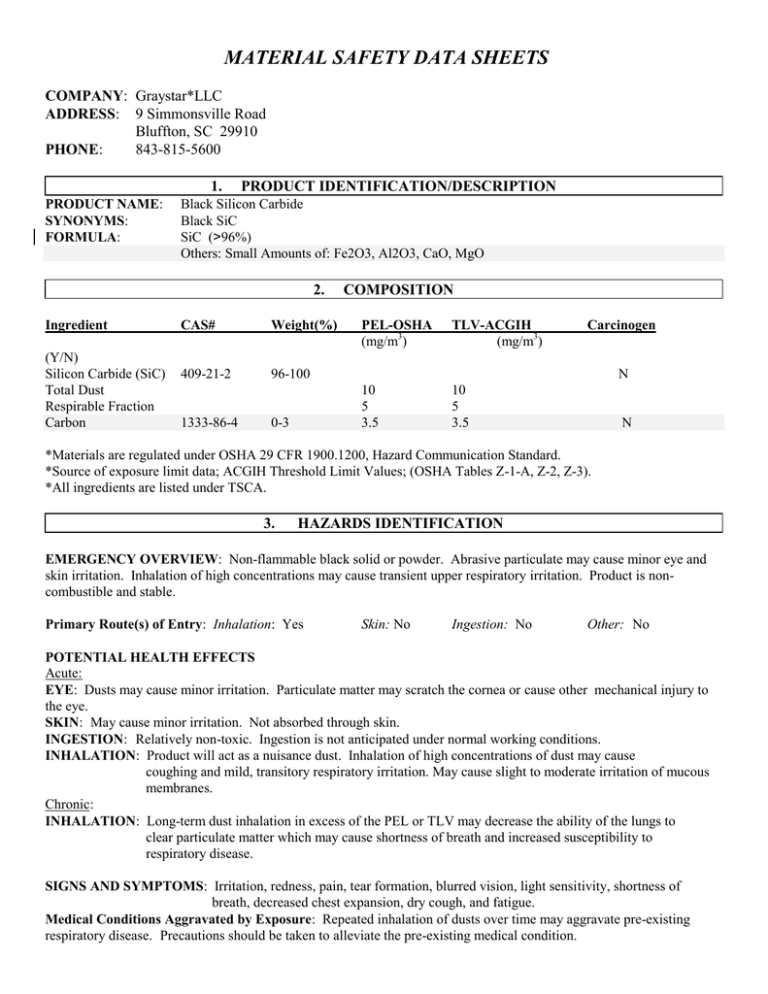
MATERIAL SAFETY DATA SHEETS COMPANY: Graystar*LLC ADDRESS: 9 Simmonsville Road Bluffton, SC 29910 PHONE: 843-815-5600 1. PRODUCT NAME: SYNONYMS: FORMULA: PRODUCT IDENTIFICATION/DESCRIPTION Black Silicon Carbide Black SiC SiC (>96%) Others: Small Amounts of: Fe2O3, Al2O3, CaO, MgO 2. Ingredient (Y/N) Silicon Carbide (SiC) Total Dust Respirable Fraction Carbon CAS# Weight(%) 409-21-2 96-100 1333-86-4 0-3 COMPOSITION PEL-OSHA (mg/m3) TLV-ACGIH (mg/m3) 10 5 3.5 10 5 3.5 Carcinogen N N *Materials are regulated under OSHA 29 CFR 1900.1200, Hazard Communication Standard. *Source of exposure limit data; ACGIH Threshold Limit Values; (OSHA Tables Z-1-A, Z-2, Z-3). *All ingredients are listed under TSCA. 3. HAZARDS IDENTIFICATION EMERGENCY OVERVIEW: Non-flammable black solid or powder. Abrasive particulate may cause minor eye and skin irritation. Inhalation of high concentrations may cause transient upper respiratory irritation. Product is noncombustible and stable. Primary Route(s) of Entry: Inhalation: Yes Skin: No Ingestion: No Other: No POTENTIAL HEALTH EFFECTS Acute: EYE: Dusts may cause minor irritation. Particulate matter may scratch the cornea or cause other mechanical injury to the eye. SKIN: May cause minor irritation. Not absorbed through skin. INGESTION: Relatively non-toxic. Ingestion is not anticipated under normal working conditions. INHALATION: Product will act as a nuisance dust. Inhalation of high concentrations of dust may cause coughing and mild, transitory respiratory irritation. May cause slight to moderate irritation of mucous membranes. Chronic: INHALATION: Long-term dust inhalation in excess of the PEL or TLV may decrease the ability of the lungs to clear particulate matter which may cause shortness of breath and increased susceptibility to respiratory disease. SIGNS AND SYMPTOMS: Irritation, redness, pain, tear formation, blurred vision, light sensitivity, shortness of breath, decreased chest expansion, dry cough, and fatigue. Medical Conditions Aggravated by Exposure: Repeated inhalation of dusts over time may aggravate pre-existing respiratory disease. Precautions should be taken to alleviate the pre-existing medical condition. TARGET ORGANS: Lungs CARCINOGENICITY: NTP: No IARC: No OSHA: BLACK SILICON CARBIDE No Page 2 of 4 4. FIRST AID MEASURES EYES: Flush eyes with lukewarm water for 15 minutes, opening and closing eyelids to ensure adequate rinsing. If redness, irritation, pain, or tearing occurs, seek medical attention. SKIN: Wash contaminated area with soap and water. Wash contaminated clothing. Seek medical attention if symptoms persist. INHALATION: If inhalation of high concentrations occurs, move to fresh air. If breathing has stopped, a certified professional should give CPR. Seek immediate medical attention. INGESTION: Do not induce vomiting unless suggested by a doctor. Seek medical attention. 5. FIRE FIGHTING MEASURES FLASH POINT: Not Applicable FLAMMABLE LIMITS: LEL: Not Applicable UEL: Not Applicable AUTO IGNITION TEMPERATURES: Not Applicable. EXTINGUISHING MEDIA: Use media appropriate for surrounding fire. FIRE AND EXPLOSION HAZARDS: Non-flammable, non-combustible. Product will not burn. HAZARDOUS DECOMPOSITION PRODUCTS: None FIRE FIGHTING INSTRUCTIONS: Firefighters should wear a NIOSH/MSHA approved full-faced self-contained breathing apparatus (SCBA) operated in positive pressure mode and full turnout or bunker gear. NFPA CLASSIFICATION: HEALTH: 0 FLAMMABILITY: 0 REACTIVITY: 0 6. ACCIDENTAL RELEASE MEASURES Isolate hazard area and deny entry to unauthorized and/or unprotected personnel. Avoid dust generation. Water mist may be added as necessary to control the level of airborne dusts. Respiratory protection for clean-up personnel depends on the level of exposure anticipated. (See Section 8. EXPOSURE CONTROLS/PERSONAL PROTECTION) Gently shovel or scoop into clean dry container for later recycle or disposal. Comply with Federal, State and Local regulations regarding reporting of spills and disposal. 7. HANDLING AND STORAGE Store in dry area in closed containers. Storage and work areas should be periodically cleaned to minimize dust accumulation. Avoid dust inhalation and promulgation. DO NOT use compressed air or dry sweeping to remove dust from work area. Dusts should be removed using an appropriately equipped vacuum. Exhaust air should be filtered through a HEPA (high-efficiency particulate air) filter. If an appropriate vacuum is unavailable, only wet clean-up methods should be used (i.e. wet sweeping, misting, etc.) Moisture should be added as necessary to reduce exposure to airborne respirable dust. See OSHA 29 CFR 1910.94 (Ventilation) and 29 CFR 1910.1000 (Air Contaminants). 8. EXPOSURE CONTROLS/PERSONAL PROTECTION RESPIRATORY PROTECTION: Under normal working conditions, below acceptable exposure guidelines, none is required. For concentrations above the PEL but less than 10X the PEL, a NIOSH/MSHA approved dust mist respirator should be worn. Appropriate respirator selection will be dependent upon the magnitude of exposure and should be selected in accordance with 29 CFR 1910.134. (See Section 2. COMPOSITION for PEL’s and TWA’s). BLACK SILICON CARBIDE Page 3 of 4 SKIN PROTCTION: Protective gloves, as needed, to prevent skin contact. EYE PROTECTION: Safety-glasses with side shields or goggles to prevent dust and particles from entering the eye. See OSHA 29 CFR 1910.133. OTHER: Under dusty conditions, employees should wear coveralls or other suitable work clothing. Contaminated clothing must be vacuumed before removal. DO NOT REMOVE dust from clothing by blowing or shaking. ENGINEERING CONTROLS: Use general ventilation. Local exhaust may be necessary for processes which generate large quantities of airborne dust. Keep exposures below applicable OSHA PEL’s and ACGIH-TLV’s. 9. Formula Molecular Weight Boiling Point Melting Point Specific Gravity (H20 = 1) Percent Volatile Evaporation Rate Solubility in Water Solubility in Alcohol pH (10% slurry) Appearance/Odor PHYSICAL PROPERTIES SiC 40.07 Not Applicable SiC does not melt but dissociates at ~2300oC 3.21 0 None Insoluble Insoluble Not applicable Black solid or powder/odorless 10. STABILITY AND REACTIVITY STABILITY: Stable under normal ambient conditions of temperature and pressure. REACTIVITY/INCOMPATIBILITY: No incompatible materials known. HAZARDOUS DECOMPOSITION: Not applicable HAZARDOUS POLYMERIZAION: Will not occur. 11. ECOLOGICAL INFORMATION Black Silicon Carbide is not expected to exert an ecotoxic effect or bioconcentrate in the food chain. 12. DISPOSAL CONSIDERATIONS Dispose of according to applicable federal, state, and local regulations. Dispose per 40 CFR 261 and 262. 13. TRANSPORT INFORMATION U.S. Department of Transportation (DOT): Not Classified BLACK SILICON CARBIDE Page 4 of 4 14. KEY ACGIH CAS DOT IARC MSHA NFPA NIOSH NTP OSHA PEL SARA TLV American Conference of Governmental Industrial Hygienists Chemical Abstracts Service Department of Transportation International Agency for Research on Cancer Mine Safety and Health Administration National Fire Protection Association National Institute for Occupational Safety and Health National Toxicology Program Occupational Safety and Health Administration Permissible Exposure Limit Superfund Amendment and Reauthorization Act Threshold Limit Valve TSCA Toxic Substance Control Act 15. DISCLAIMER Although reasonable care has been taken in the preparation of the information contained herein, the originator and Graystar*LLC extends no warranties, makes no representation and assumes no responsibility as to the accuracy of suitability of such information for application to the purchaser’s intended purposes or for consequences of its use. Rev. 04 4/15/13 (no changes required)
